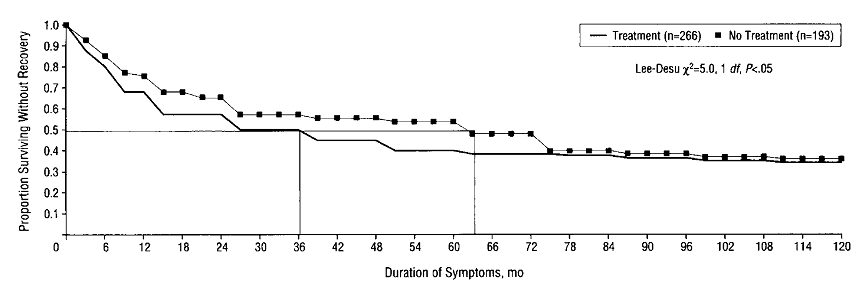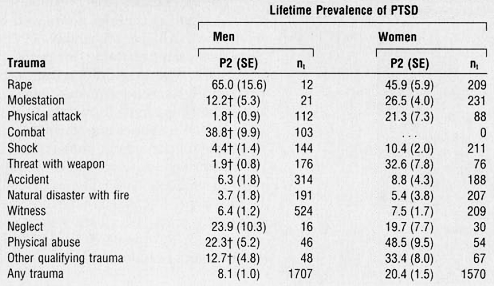This is a repost of an article I wrote in 2015.
I occasionally read social science papers, and I think it’s worth sharing what I find, even though in principle you could read about it yourself. This time I read about statistics on Post-traumatic stress disorder (PTSD) in the US, and my particular interest is in PTSD from sexual assault and rape.
A good basic overview of PTSD can be found from the US Department of Veteran’s Affairs:
Diagnostic criteria for PTSD include a history of exposure to a traumatic event that meets specific stipulations and symptoms from each of four symptom clusters: intrusion, avoidance, negative alterations in cognitions and mood, and alterations in arousal and reactivity.[1]
According to the National Comorbidity Survey (NCS), about 7.8% of people in the US have experienced PTSD in their lifetime. This is reinforced by the NCS-R (a replication of the original study) which found 6.8% prevalence. However, just because someone has suffered from PTSD doesn’t necessarily mean they’re still suffering; Only 3.5% have had PTSD in the past year.[2] Here’s a timeline of PTSD recovery:

This is Figure 2 from Ref. 3, showing the fraction of people who continue to have PTSD after the indicated number of months. People who get treatment (solid line) are 50% likely to recover after 3 years, and people who don’t get treatment are 50% likely to recover after 6 years. About one third seem to never recover. This means that PTSD treatment should not just focus on recovery, but also on living well alongside PTSD.
Common examples of trauma include rape, live combat, and living through a major accident or natural disaster. Obviously any of these are bad on their own, but add to that the probability of PTSD, which may potentially affect the person for the rest of their lives.
Now, the probability that someone exposed to trauma will suffer from PTSD is thankfully low. According to the NCS,[3] only 17.9% of those exposed to trauma have ever suffered from PTSD. However, this number breaks down, because it depends on the kind of trauma in question. Thus when newer editions of the DSM redefine trauma, the percentage may change.
The other thing that PTSD depends on is gender. It turns out that women are twice as likely to suffer from PTSD, even though they’re slightly less likely to be exposed to trauma. You might guess that this is because women are more likely to be raped, and because rape is the kind of trauma most likely to cause PTSD. While true, a more recent study shows that women are also twice as likely to suffer from PTSD within any particular category of trauma.[4]
I would have liked to give numbers for how likely men and women are to suffer from PTSD given any trauma type. Unfortunately, the numbers are not available in the studies I read, because of methodological limitations. Most people who have been exposed to trauma have been exposed to more than one trauma. The standard method of dealing with this is to ask people to single out the worst trauma that they’ve experienced, called the “index event”. The rest of the questions are answered in relation to the index event. This overestimates the rate of PTSD, since the index event is more likely to cause PTSD.

Nonetheless, here are numbers from Ref. 3, Table 4 (edited to remove some extraneous information). P2 is the likelihood that someone who picked a particular trauma type as their index event also suffered from PTSD associated with that event. The parentheses indicate standard errors. The column labeled “n” shows the number who chose a particular kind of trauma as their index event and had associated PTSD. As you can see, rape is the most likely kind of trauma to be associated with PTSD, although combat and physical abuse are also up there.
Another interesting factoid: the likelihood of women to experience rape was 9%, where for men it was 1%.[5] But probably there are better studies to find such estimates–the NCS used a relatively restrictive definition of rape.[6] FYI, I do volunteer work for a survey and rape is one of the things we want to ask about. It makes me feel better that our amateur survey can at least do better than the National Comorbidity Survey, but this should make literally no one else feel better.
On a final personal note, I’m male, have been sexually assaulted a few times, but have not ever had PTSD. I’ve seen a lot of people assume PTSD is the only way to respond to sexual assault, which is annoying. But probably not nearly as annoying as PTSD would be, so there’s that.
1. For more details, see the DSM-5 fact sheet on PTSD. But note that all the papers I read use diagnostic criteria from earlier versions of the DSM. (return)
2. Kessler et al., Prevalence, Severity, and Comorbidity of Twelve-month DSM-IV Disorders in the National Comorbidity Survey Replication (NCS-R). Arch Gen Psychiatry. 2005 Jun; 62(6): 617–627. (return)
3. Kessler et al., Posttraumatic stress disorder in the National Comorbidity Survey. Arch Gen Psychiatry. 1995 Dec;52(12):1048-60. (return)
4. Breslau et al., Influence of predispositions on post-traumatic stress disorder: does it vary by trauma severity? Psychol Med. 2013 Feb;43(2):381-90. (return)
5. Note that the male/female difference probably only applies to heterosexual people. See Table 1 of Balsam et al., Victimization Over the Life Span: A Comparison of Lesbian, Gay, Bisexual, and Heterosexual Siblings. J. Consult. Clin. Psych. 2005;73(3): 477–487. (return)
6. The NCS’s definition of rape is “someone had intercourse with you when you did not want to by threatening you or using some degree of force”. A lot of rape involves coercion, implicit threat, or intoxication, and I’m not convinced that survey respondents would recognize their experiences under this definition. (return)

Are men actually less likely to suffer PTSD, or are they simply less likely to admit they have it/ask for help?
#StatsAreGreat <3
My guess is that the reason PTSD crops up more frequently in women after a traumatic event is that PTSD results from the sense of extreme unsafety, and women suffer from a constant background of being made to feel unsafe. The rape (or whatever) is simply a more extreme version of what they suffer all the time. Moreover, for people to recover from PTSD (with or without treatment), getting the sufferer into an environment where they can feel safe and are actually safe is an absolute prerequisite, one which is frequently difficult to obtain for women, e.g., if the perpetrator is a family member or spouse, or if they are poor and are forced to live in dangerous circumstances. Also, healing from trauma requires emotional support, and women who are raped or otherwise abused are routinely disbelieved and victim-blamed, to the point that they usually don’t even try to report it.
For similar reasons, I wouldn’t be surprised if African-Americans also have a higher rate of PTSD per traumatic incident than whites.
Also keep in mind that PTSD is frequently not diagnosed as such, particularly if the symptoms differ from the expected presentation. FWIW, from my reading, the APA was reluctant to include it in the DSM at all.
There’s also C-PTSD, which probably wasn’t included in the stats you’re describing, since the APA refuses to admit it exists. It involves trauma that goes on over a long period of time, and while it may include flashbacks, it also results in things such as dissociation (e.g., DID, a.k.a. Multiple Personality Disorder), somaticization disorders, and borderline personality disorder, which are frequently not diagnoses as resulting from long-term trauma. (Well, DID should be — AFAIK, the connection has been known for a long time.) The symptoms may not look like stereotypical PTSD, but the mechanisms are similar.
FWIW, The Body Keeps the Score (van der Kolk) is a good and readable source for what is known about trauma. Judith Herman’s Trauma & Recovery is older but still good.
@Siobhan,
In the study, PTSD is not self-reported, but diagnosed based on symptoms. Of course, the symptoms themselves are self-reported, so this is still consistent with your hypothesis.
@AMM,
Someone raised the same possibility before, but it turns out that the association between race/ethnicity and PTSD is much weaker than the association between gender and PTSD. See comments in the old post.
I am not sure how much the rate of PTSD depends on the precise list of symptoms chosen. To check this claim, you might try comparing different studies which define PTSD under different versions of the DSM. It seems like the choice of symptoms should, if anything, overdiagnose men (or underdiagnose women), since PTSD was originally coined to describe male veterans.